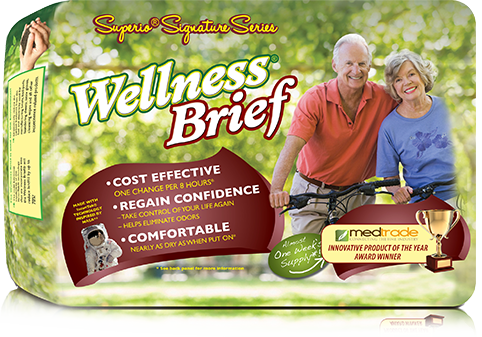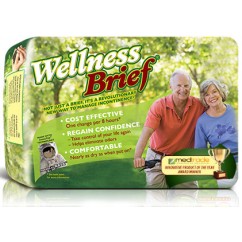Adult incontinence is an insidious medical problem in modern society. According to the Urology Care Foundation, 25-33% of adult Americans grapple with some form of urinary incontinence (UI). The numbers could be higher considering that many people suffer in silence due to the stigma associated with symptoms of incontinence. In most cases, the problem arises due to problems with the bladder. However, this is not always the case. Functional incontinence is a situation where an individual experience involuntary loss of urine due to physical or emotional impairment. For people suffering from functional incontinence, the issue is not bladder control, but rather an inability to get to the washroom in time. It is important to learn what you can about this problem and how to manage it using incontinence products such as adult diapers for a woman.
Functional incontinence can take on many forms depending on the situation the sufferer is facing. In this article, you will get more insight about some of them:
Functional Incontinence in Brief
To understand functional incontinence, imagine this situation. Your elderly loved one, who has arthritis, suddenly feels the urge to go. Their bladder works perfectly but the problem arises when they try to move out of their bed. The pain and poor mobility eventually lead to a loss of urine before they can get to the washroom. This is just one scenario that can lead to incontinence.
While most people associate incontinence with a loss of bladder control, physical and emotional problems also contribute greatly to the problem. Doctors refer to the loss of control on the bladder or bowel caused by a physical or emotional hindrance, as functional incontinence. This makes it important to gather as much information as possible about the problem, to find a proper way to treat it.
- Symptoms of Functional incontinence
If you or a loved one suffers from an involuntary loss of urine, it is important to assess whether the problem falls under functional incontinence. Functional incontinence entails the passing of urine before getting to the toilet for one reason or another. In some cases, it is a temporary problem. In others, it is a long-term condition, which requires proper management. As a caregiver, you need to monitor your patient closely to determine if their incontinence arises due to some form of physical or mental problem.
- Causes of Functional Incontinence
The human bladder has an ideal capacity of urine it can hold, and control of the duration for which it can hold such liquid. When the bladder reaches its capacity, it immediately sends a signal to the brain, which in turn leads to nerve action causing you to feel the urge to go. For most people who suffer from incontinence, there is no control over the bladder meaning a release of urine can happen even before the bladder reaches its capacity.
However, in the case of functional incontinence, the system works perfectly and even after the brain starts sending the signal about the need to go, the individual is fully aware. Unfortunately, a barrier prevents them from getting to the toilet in time. These barriers fall into two categories:
i. Physical barriers: These can arise due to medical conditions such as arthritis, joint pain, back pain, spine injury, blindness, medications, neurological problems including Parkinson’s disease or multiple sclerosis (MS) that could cause a hindrance to the ability to reach the bathroom or remove clothes in time, or in poor mobility when using a wheelchair among other issues.
ii. Emotional/ mental barriers: Problems with thinking or communicating are a major cause of incontinence, especially among the elderly. Medical conditions such as dementia, severe depression, multiple sclerosis are only a few of the causes of functional incontinence. This means that even when an individual feels the urge to go, the mental condition prevents them from making the right decision.
Treating and Managing Functional Incontinence
i. Proper diagnosis: Treatment for any form of incontinence starts with a proper diagnosis. If you suffer from incontinence yet you have good bladder control; it is important to talk to your doctor. As a family member or caregiver, you have to take charge of your patient’s incontinence problem by seeking the opinion of a doctor.
ii. Address the cause: Treatment starts with addressing the condition that causes incontinence. In the case of a medical problem such as arthritis, dementia or any other problem, your doctor may recommend further tests by a specialist for proper diagnosis and treatment.
iii. Increase accessibility: A caregiver will need to review the physical environment of a patient to improve access to the toilet. Many families solve the problem by building a toilet closer to their elderly loved one’s room or by providing a convenient way of passing urine when the urge arises. Making a home elder-friendly will improve access for your loved one and will decrease episodes of incontinence.
iv. Arthritis-friendly clothing: The right choice of clothing can greatly help with functional incontinence. People who have arthritis will find it hard to operate zippers and buttons and should use easy to pull on Adaptive Arthritis Apparel instead. These include wrap-around designs, ‘easy grip’ side zips, pop-fasteners, adaptive open side pants, adaptive open side skirts, front open bra, magnetic shirt/ blouse for easy closure, adjustable, easy-touch closure slippers among others.
v. Bladder training: You can manage incontinence by scheduling the amount of time between bathroom trips. If an urge arises, stand or sit still then contract the pelvic muscles. At the same time, concentrate on something else until the urge to urinate goes away.
vi. Scheduled, timed, or prompted voiding: This is a successful technique for patients with dementia. It entails setting a schedule for bathroom trips. This technique requires motivation and effort but the outcome is great in dealing with functional incontinence.
vii. Kegel exercises: These pelvic muscle exercises strengthen the muscles around the bladder and urethra thus preventing leakage. Walking helps improve these muscles.
viii. Using adult diapers: Incontinence products remain the most effective way of dealing with any form of incontinence. To avoid embarrassing accidents, use the best incontinence products such as adult diapers for a woman. The best diapers for women are high absorbent, comfortable and skin-friendly, and feature the use of odor control technology and breathable panels.
It is true that dealing with any form of incontinence as a patient or caregiver or family is not easy. For functional incontinence, it is important to understand the underlying cause through a diagnosis from the doctor. This will lead to effective treatment. Using the best incontinence products is also a foolproof way of preventing accidental leaks and you will always enjoy peace of mind, knowing you have the best protection.

